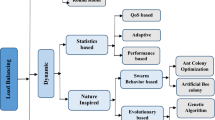Abstract
With the development of cloud computing, a growing number of workflows are deployed on cloud platform that can dynamically provides cloud resources on demand for users. In clouds, one basic problem is how to schedule workflow for minimizing the execution cost and the workflow completion time. Aiming at the problem that the maximum completion time and cost of multiple workflows are too high, this paper proposes a model of dynamic multi-workflow scheduling in cloud environment and a new scheduling algorithm which is named as MT (multi-workflow scheduling technology). In MT, the heterogeneity of resources is considered when calculating the priority of tasks. Then, the technique for order of preference by similarity to ideal solution (TOPSIS) method is used to rank the resources when selecting resources for tasks. Finally, MT takes the estimated minimum completion time of the workflow and the cost of the task as two attribute indexes in TOPSIS decision matrix. Also, it uses a fixed reference point instead of calculating ideal solution, which ensures the uniqueness of the evaluation criteria when there is a change in the number of resources. Simulation experiments are illustrated to verify the effectiveness of the proposed algorithm in reducing the maximum completion time and cost of multiple workflows. Compared with the state-of-the-art methods, the maximum completion time and cost can be reduced by at most 17 and \(9\%\), respectively.











Similar content being viewed by others
Notes
The Technique for Order of Preference by Similarity to Ideal Solution (TOPSIS) is a multi-criteria decision analysis method, it is based on the concept that the chosen alternative should have the shortest geometric distance from the positive ideal solution and the longest geometric distance from the negative ideal solution [10].
References
Xia Y (2015) Cloud control systems. IEEE/CAA J Autom Sinica 2(2):134–142
Xia Y, Yan C, Wang X (2019) Intelligent transportation cyber-physical cloud control systems. Acta Autom Sinica 45(1):132–142
Atmaca T, Begin T, Brandwajn A, Casteltaleb H (2016) Performance evaluation of cloud computing centers with general arrivals and service. IEEE Trans Parallel Distrib Syst 27(8):2341–2348
Xie G, Chen Y, Li R, Li K (2018) Hardware cost design optimization for functional safety-critical parallel applications on heterogeneous distributed embedded systems. IEEE Trans Industr Inf 14(6):2418–2431
Yassir S, Mostapha Z, Claude T (2017) Workflow scheduling issues and techniques in cloud computing: a systematic literature review. In: Proceedings of the International Conference of Cloud Computing Technologies and Applications, pp. 241– 263 . Springer
Bardsiri AK, Hashemi SM (2012) A review of workflow scheduling in cloud computing environment. Int J Comput Sci Manag Res 1(3):348–351
Topcuoglu H, Hariri S, Wu M-y (2002) Performance-effective and low-complexity task scheduling for heterogeneous computing. IEEE Trans Parallel Distrib Syst 13(3):260–274
Braun TD, Siegel HJ, Beck N, Bölöni LL, Maheswaran M, Reuther AI, Robertson JP, Theys MD, Yao B, Hensgen D et al (2001) A comparison of eleven static heuristics for mapping a class of independent tasks onto heterogeneous distributed computing systems. J Parallel Distrib Comput 61(6):810–837
Sakellariou R, Zhao H, Tsiakkouri E, Dikaiakos MD (2007) Scheduling workflows with budget constraints, 189–202
Assari A, Mahesh T, Assari E (2012) Role of public participation in sustainability of historical city: usage of topsis method. Indian J Sci Technol 5(3):2289–2294
Lin C, Lu S ( 2011) Scheduling scientific workflows elastically for cloud computing. In: Proceedings of the 4th IEEE International Conference on Cloud Computing, pp. 746– 747 . IEEE
Rodriguez MA, Buyya R (2014) Deadline based resource provisioningand scheduling algorithm for scientific workflows on clouds. IEEE Trans Cloud Comput 2(2):222–235
Chen Z-G, Zhan Z-H, Li H-H, Du K-J, Zhong J-H, Foo YW, Li Y, Zhang J (2015) Deadline constrained cloud computing resources scheduling through an ant colony system approach. In: 2015 International Conference on Cloud Computing Research and Innovation, pp. 112– 119 . IEEE
Su S, Li J, Huang Q, Huang X, Shuang K, Wang J (2013) Cost-efficient task scheduling for executing large programs in the cloud. Parallel Comput 39(4–5):177–188
Li H, Wang B, Yuan Y, Zhou M, Fang Y, Xia Y (2021) Scoring and dynamic hierarchy-based nsga-ii for multiobjective workflow scheduling in the cloud. IEEE Trans Autom Sci Eng. https://doi.org/10.1109/TASE.2021.3054501
Chen Z-G, Zhan Z-H, Lin Y, Gong Y-J, Gu T-L, Zhao F, Yuan H-Q, Zhang J (2019) Multiobjective cloud workflow scheduling: a multiple populations ant colony system approach. IEEE Trans Cybern 49(8):2912–2926
Zhu Z, Zhang G, Li M, Liu X (2016) Evolutionary multi-objective workflow scheduling in cloud. IEEE Trans Parallel Distrib Syst 27(5):1344–1357
Garg R, Singh AK ( 2011) Multi-objective workflow grid scheduling based on discrete particle swarm optimization. In: International Conference on Swarm, Evolutionary, and Memetic Computing, pp. 183– 190 . Springer
Hsu C-C, Huang K-C, Wang F-J (2011) Online scheduling of workflow applications in grid environments. Futur Gener Comput Syst 27(6):860–870
Lai Y-J, Liu T-Y, Hwang C-L (1994) Topsis for modm. Eur J Oper Res 76(3):486–500
Zhan, Y (2022) https://github.com/Ray-ZHAN/workflow-scheduling. [Online; accessed 06-Jun.-2022]
Acknowledgements
All codes and data are published on GitHub [21]. There is no conflict of interest in this paper.
Author information
Authors and Affiliations
Corresponding author
Additional information
Publisher's Note
Springer Nature remains neutral with regard to jurisdictional claims in published maps and institutional affiliations.
Rights and permissions
About this article
Cite this article
Xia, Y., Zhan, Y., Dai, L. et al. A cost and makespan aware scheduling algorithm for dynamic multi-workflow in cloud environment. J Supercomput 79, 1814–1833 (2023). https://doi.org/10.1007/s11227-022-04681-3
Accepted:
Published:
Issue Date:
DOI: https://doi.org/10.1007/s11227-022-04681-3




